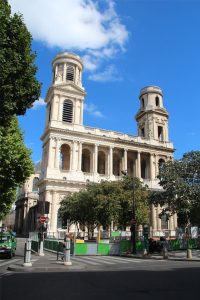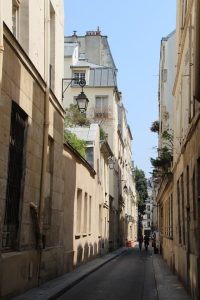History
Jacques Lefèvre d’Etaples was born in 1455 and died in 1536. He was named after his birth place in Picardie. He was consecrated priest and appointed librarian for the abbey in 1507 by abbot Guillaume Briçonnet, who was born 1472 and died in 1534. There, he began his translation of the New Testament into French.
After being appointed bishop of Meaux, Guillaume Briçonnet reformed his diocese by restoring Church discipline and developing preaching. Lefèvre d’Etaples, who had belonged to the group working on this restoration, was condemned by the Sorbonne for his translation of the New Testament into French. He took refuge in Strasbourg from where Francis I called him in 1526. He was then protected by Marguerite de Navarre, the King’s sister. He wrote commentaries on Paul’s Epistles, which make him one of the great Reformers’ forerunner.
During the siege of Paris between 1590 and 1594, Henri IV had a lookout post set up in the clock tower of Saint Germain des Prés abbey, then outside Paris walls.
In the neighbourhood
North of the abbey at 13 rue de l’Abbaye at the bottom of the staircase at the far left-hand side of the courtyard, a bust of Francis I and a statue of Michel de l’Hospital can be seen. Upon the request of Catherine de Médicis the latter organised the Poissy Colloqium in 1561, a vain attempt to conciliate Catholics and Protestants.
In the garden to the south of the abbey stands a bronze statue of Bernard Palissy, a famous Protestant ceramicist who died in captivity at the Bastille in 1589, after he was sentenced to be hanged and burnt because he was a Huguenot.
Very close to the abbey, in the rue du Marais – presently called rue Visconti – an informal assembly met and prayed, read the Bible and sang psalms, thus forming a planted Reformed Church.
The street was nicknamed ‘little Geneva’ as many Reformed lived there. They started burying their dead very discretely in the rue des Saints Pères cemetery columns and a plaque at number 30 perpetuate the memory.
The first pastor of the community was Jean Le Maçon de Launay called La Rivière, a student in law who had been in Geneva and Lausanne and attended the first national synod from 25 to 29 May 1559. It was secretly held at the house of a >Protestant called Le Vicomte at 4 rue Visconti in an inn with two exits. The first reformed baptism was held in the inn, as early as 1555.
The first national synod was presided over by François de Morel, a pastor who had come back to France after two years in Geneva. 72 Churches planted all over France were represented. The synod adopted a Confession of faith and a Code of Church Discipline which became the operating rules for the Churches.
The planted Churches were endowed with a council of elders and a pastor who could give the two sacraments acknowledged by the Reform: Holy Communion and Baptism.
Around Saint-Germain des Prés
1-3 Place Saint-Germain des Prés, 75006 Paris, France






